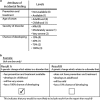Availability of treatment drives decisions of genetic health professionals about disclosure of incidental findings
- PMID: 24496062
- PMCID: PMC4169537
- DOI: 10.1038/ejhg.2014.11
Availability of treatment drives decisions of genetic health professionals about disclosure of incidental findings
Abstract
Contrasting opinions exist regarding the disclosure of incidental findings detected through clinical genomic testing. This study used a discrete choice experiment to investigate genetic health professionals' preferences for the disclosure of incidental findings in an Australian paediatric setting. Four attributes of conditions relating to incidental findings were investigated: availability of prevention and treatment, chance of symptoms ever developing, age of onset and severity. Questionnaires from 59 Australian genetic health professionals were analysed. Results show that when evaluating incidental findings for disclosure, these professionals value the availability of prevention and treatment for the condition above all other characteristics included in the study. The framework of this discrete choice experiment can be used to investigate the preferences of other stakeholders such as paediatricians and parents about disclosure of incidental findings. The results of this study may be considered when assessing which categories of incidental findings are most suitable for disclosure in clinical practice.
Figures

References
-
- Sagoo GS, Butterworth AS, Sanderson S, Shaw-Smith C, Higgins JPT, Burton H. Array CGH in patients with learning disability (mental retardation) and congenital anomalies: updated systematic review and meta-analysis of 19 studies and 13,926 subjects. Genet Med. 2009;11:139–146. - PubMed
-
- Jackson L, Goldsmith L, O'Connor A, Skirton H. Incidental findings in genetic research and clinical diagnostic tests: a systematic review. Am J Med Genet. 2012;158:3159–3167. - PubMed
-
- Berg JS, Khoury MJ, Evans JP. Deploying whole genome sequencing in clinical practice and public health: meeting the challenge one bin at a time. Genet Med. 2011;13:499–504. - PubMed
Publication types
MeSH terms
LinkOut - more resources
Full Text Sources
Other Literature Sources

